#dalish design
Text
Exalted Plains

The Exalted Plains, also known as Dirthavaren ("the promise") in elvish, is a grassland region of the Dales in Orlais. Centuries ago, the Dalish kingdom met its end here, the holdouts of the elven army making their last stand, refusing to surrender against the champions of Andraste: the templar, the sister, and the nobleman patron. The champions' cause was just, and their faith led them to victory. The plains were henceforth called "Exalted". After the elves' defeat and the dissolution of their kingdom, Ville Montevelan became the first human settlement in the Dales, presided over by Revered Mother Amity, Champion of the Exalted March.
Currently, the region is a contested battlefield during the War of the Lions until Empress Empress Celene and Gaspard de Chalons's armies agreed to cease hostilities.
[This is part of the series “Playing DA like an archaeologist”]

When entering this zone, Solas explains that this place has a thin Veil product of the battles that happened long time ago: the Exalted March of Dales. So we know we are going to see a mixture of elven ruins and human settlements.
Scout Harding will inform us that in the area there is a group of rebels who are tired of the War of the Lions, and wants the Dales for themselves.
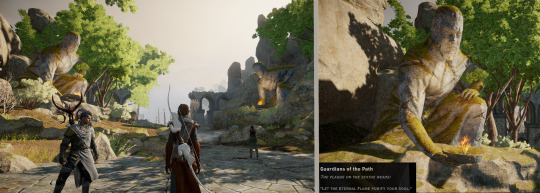
The first thing we see when we enter this zone are these statues that, design-wise, they are very, very close to the Humanoid Dirthamen/Falon'Din. Humanoid Dirthamen/Falon'Din is a squatted hooded figure, who doesn’t have any object in his hand. This one holds a plate which works as a brazier. In fact, the elven statues are placed in this entrance, but on the Emerald Graves side:

They are called Guardians of the Path, and by the note they trigger, they are Andrastian. Still the striking similarity between these statues and the one we associate with Dirthamen makes me suspect that, once conquered, the Orlesians repurposed the native statues.

The first ruin we find, which surrounds the camp, is an elven one, with a dragon painting on one of its columns.
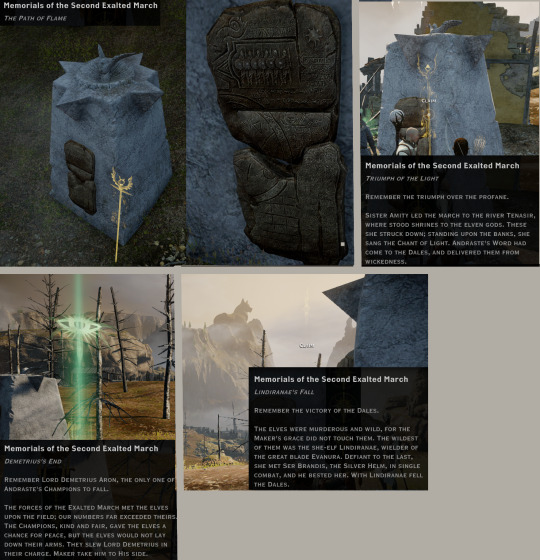
Besides the path there is a rectangle statue which on its top has a star-shaped fountain with a dove. On a side there is a reused elven/dwarven relic tablet that will trigger the codex Memorials of the Second Exalted March which will be updated as we read all these stones spread in the region. They explain how the “battle” against the elves was happening, mixing Andrastre’s tale with probably bits of History. It’s very curious how this piece of information depicts the elves as proud and murderous, far away from the Maker and Andraste, which is clearly a lie when we analyse Di’nan Hanin; these Dalish, unlike modern Dalish, had fused Andraste cult into their elven pantheon, not without reason: It had been some decades since they had recovered these lands thanks to Andraste’s promise.
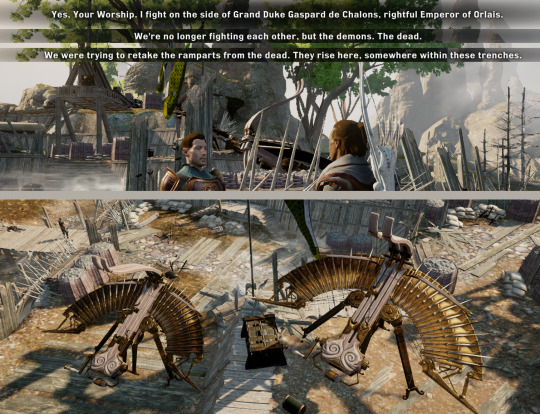
The zone has several ramparts where the imperial army [either side] is trying to retake control from the undead and the demons. Recovering each of these is quite a repetitive task all over the place.

The only important comment about these ramparts is that they give us some idea to understand the function of these Strange Skull-Dragon totem : They seem to hold barriers around pits that allow the dead to rise, and also as columns surrounding zones with many undead or demons. They seem to be related to summoning rituals.
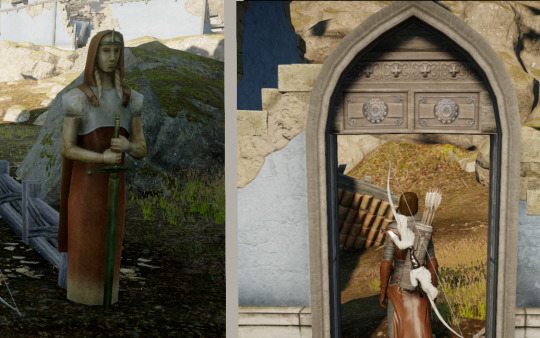
Along the region we find several Andrastian statues and the typical orlesian style in the remnants of the houses that still stand.


Fort Revasan shows the standard elven patterns of any elven ruin. The Orlesian occupation built extra, less durable additions with chess-like floors and decorated wooden elements.

Close to Fort Revasan there is a sealed entrance that requires a war table operation to be solved in order to open. It shows a Fen’Harel statue, guarding the entrance. It’s a nice detail to see that the base of his statue shows an eluvian-like pattern worth to keep present.

Very far away in the North, over the mountains that surround this region, we see a big Fen’Harel statue observing the Exalted Plains. It’s hard to guess what this zone represented in the time of the Elvhenan [not the Dalish kingdom]. This place has 3 main elvhen ruins: the one in the North Rampart, the Ghilan’nair’s grove, and the Graveyard Var Bellanaris. There are more than these, but they are too destroyed or small. It’s hard to ponder if all of them date of the same time.
At some kilometres of distance from the Fen’Harel’s statue, we see a tower of radical different style. At a single glance, we can see it’s Tevinter. More details of this in the Post about Exalted Plains: Citadelle du Corbeau.

Riverside Garrison is another elven ruin which patterns make it look like Elvhen: flower pattern, square pattern and swirl pattern.
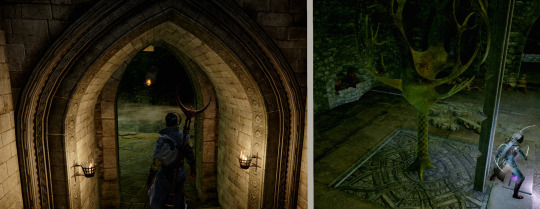
Inside, we find more elements that allows us to suspect this is Elvehan from the time when the Veil did not exist. There is an elaborated tile that we will see in puzzles in the Temple of Mythal, and one of those rounded trees, growing out of it.
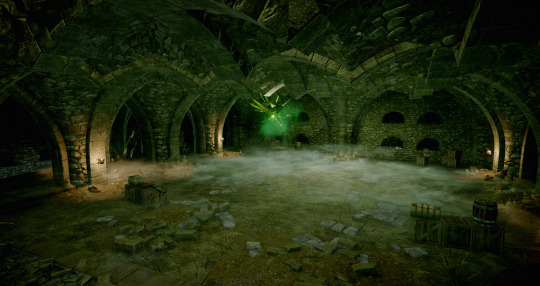

With the exception of the rounded tree, the decoration looks like an elvehnan crypt; its style is the same one we found in the crypts of the Temple of Mythal. There are bodies, skeletons and urns everywhere. Of course, DAI has several bodies and skeletons that they use for everything dead, so I won’t focus on the armour or the details of these objects. They are always the same no matter what kind of dead you are looking at: an avvar body, an elven body or a dwarven body.

Close to Revasan Fort, there is a collapsed bridge decorated with a statue of Andraste and a landmark called Pont Agur. It explains with dubious accuracy that after the Exalted March of the Dales some villagers drown trying to cross the river, so the mayor built this bridge and dedicated it to humans and elves too. This started a rumour about the mayor having elven blood, and had to step down. I think this shows how complex was this land after the March; these things [elves and humans in relationships] have been happening since long time ago, as the Tomb of Elandrin shows us with the incident of Red Crossing. For more details read Emerald Graves: Din’an Hanin, Tomb of Elandrin.

Beside Port Agur we find villa Montevelan, where this story of the mayor happened. This was the first human settlement after the Exalted March of the Dales. It’s all destroyed now.

Inside some ramparts we can see big trees that got my attention: I don’t know if they can be considered the original vhenadahl, the trees that the city elves try to grow as a memory of their Dalish roots. These trees can be found in ramparts as well as in the Citadelle du Corbeau. In many times, they show bodies hanging from its branches, so they inspire some murderous sentiment to such an elven symbol [if these tree are supposed to be vhenadahl, I’m just guessing since these can’t be found in other elven ruins, so they seem to be more Dalish than Elvish to me.]

In this rampart in particular, we find a difference in comparison with the rest of the ramparts in the area: there is a small tower which construction date is hard to guess. It could have been built during the Exalted March or a bit earlier. The entrance is decorated with these enigmatic tablets, depicting the Razikale Ceremony and the Horned warrior holding a sword. We have established they were Tevinter due to their presence in Coracavus and The Still Ruins. Inside the tower we find a Tevinter inspector, Tevinter containers, and minor, decorative Tevinter elements. Inside this tower there is a codex about Legend of the Three Sisters: Book 3, which makes the player aware of how stories change depending on factors such as historical-political situation, countries or censorship. This is yet another call out that the game does to us, players, to not take every single story we read as 100% true.
It seems that Tevinter mages were present in the Exalted Plains at some point in History and performed some magic or experiments. Considering the Strange Skull-Dragon totem and the undead all over the place, I would be inclined to think that some faction during the Exalted March invited Tevinter mages to provide efforts in the battle. Which is a very odd concept if we remember that it was a war between Elves [many of them coming from families who had fought Tevinter by Andraste’s side to recover their freedom] and the Chantry of that time [which always had some frictions with Tevinter].
I thought in a possibility to explain this Tevinter presence: since many of the elves that fought in the Exalted March belonged to families that had been former slaves of Tevinter mages, some of them could have developed a vast knowledge of Tevinter arcane magic. I have the impression this is more or less proven in the Citadelle du Corbeau, where elves may have installed a Tevinter defence system in an elven ruin. Because of this last fact, I’m a bit inclined to think this is the reason why we find Tevinter elements in this region. However, that doesn’t add up that we find these tablets, which are more related to Tevinter gods and ceremonies than Elven ones. I can imagine elves resorting to Tevinter devices against the Chantry, but hardly performing rituals to Tevinter gods.
As a conclusion I don’t think we can make a decent explanation of why we find so many Tevinter objects in the ramparts and elven ruin when there is no Tevinter building in the whole region.
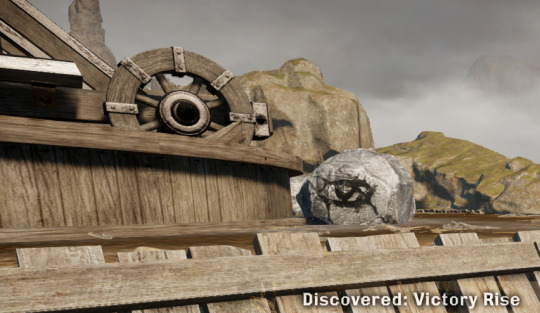
We see this rock with an eye in many places of Exalted Plains, usually, but not exclusively, representing the attack of Orlesians [at least in the context of Exalted Plains and Emerald green]. During the main quest, in the attack to Adamant Fortress, it was the Inquisition who used these stones. Clearly a reused asset with little meaning, so I will skip it.
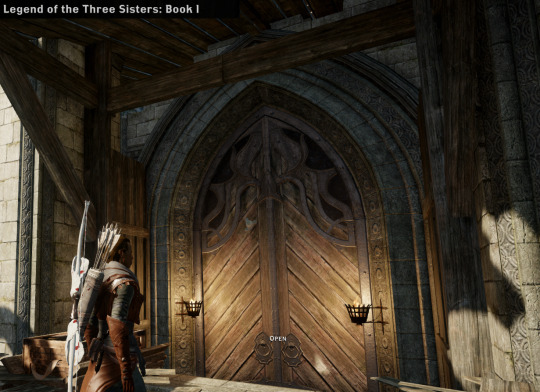
In Victory Rise we find more Elven ruins: we can see the elven patterns of swirls and flowers around this door. In this place we find the codex of Legend of the Three Sisters: Book 1.
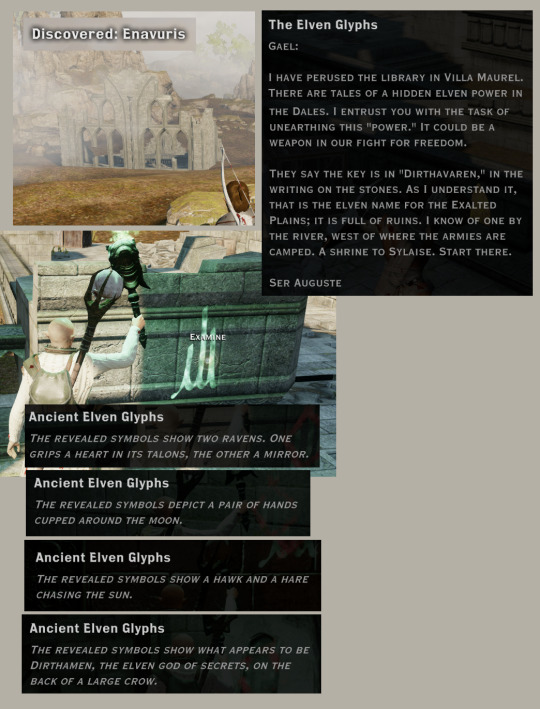
In Enavuris [such a name to confuse it so easily with Evanuris] we find a ruin that, after inspection, allows you to follow a quest to look for ancient elven glyphs. The power that the note The Elven Glyphs talks about ends up being the “Dirthamen’s wisdom”, a strange shield that can be found at the end of the exploration of the Lost Temple of Dirthamen which has an oddly Tevinter look. [See the post related to the Lost Temple of Dirthamen]. It’s hard to understand what each of these symbols that appear in the glyphs mean. Clearly, all of them are secrets, such it is the nature of Dirthamen. A brief, potential analysis can be found in the post of the Lost Temple of Dirthamen.

In Halin’sulahn we find a very small Dalish clan. They are placed close to a rock which shows the usual painting of a yellow halla, and the one that looks like a battle with many elves on hallas. There is also a statue of a hart. After talking with the Keeper of this clan we are informed about several elven-issues that the War of the Lions has caused.

The encampment shows the typical Dalish symbols: these fences with ragged hides and tree branches paint in red or green on them.

I always like to highlight that the Aravels keep these undulating lines that make me remember the undulating patterns in many, if not all, murals found in DAI. It is also worth remembering that the aravels were prison-ships filled with slaves that sent elves to dwarven cities [check The Horror of Hormak].


In search for those ancient elven glyphs, we explore a zone called Ancient Baths. By its name it seems to be an elven building which allowed baths in the river. Its entrance is decorated with two archer statues, and two wall paintings: the yellow halla, and the black twisted halla with white elves wearing vallaslin [the Dalish “remember” that golden hallas guided The people to places where they needed to be, specially in desperate times. The truth behind that probable is more twisted]. Every time I see these paintings I suspect that this building was meant to be used by slaves.
As we proceed, we find a point where we need to jump off. This chamber, in its configuration [not grandeur], looks like the Temple of Mythal's main chamber where the priest stays in a high place, inaccessible to reach [no stairs in this chamber], looking from above down to the petitioner.
This section has ancient elven decorative elements: two inuksuit decorated with red swirls and a central squared stone, both elements used for the elven dead. More than half of the ruin has fallen apart but it seems to give an idea that this building was meant to be used to see baths in the river.

As it can be seen, the decoration is ancient elvhen.

As we explore the map, we find this statue which triggers Andruil's Messenger, a codex that produces more confusion than understanding of who is the god behind the owl symbol. There is a painting of a yellow halla beside the statue. Since it is an information given by Gisharel, it may be extremely wrong. The tale almost hides a command: the people, aka the slaved elves, will follow Andruil, she will tell them when to hunt, when to raise hallas, and when to settle down. And for that, she will use an owl. Since we do not truly have better sources confirming that the owl, crow, or raven are Dirthamen’s sacred animal, it’s hard to suspect how much of this tale has been twisted along the Dalish history.

In the open we see more of these four painting together: The row of slaved elves, The Armoured Figure, The Vallaslin shifting halla, and the black halla with elves wearing vallaslin. All these paintings together seem to speak about elves being capture, alienated [ they have no face nor heart] under the control of a symbol we have seen a lot: the golden ring, and these slaves are related to vallaslin and deformed hallas that shift. For more detail, see the post Nation Art: Elvhen.

Several times in the open we can find these owl statues or the archers. Sometimes even marking a path, as if they were guiding us to some places. Sometimes they are accompanied with the paintings.
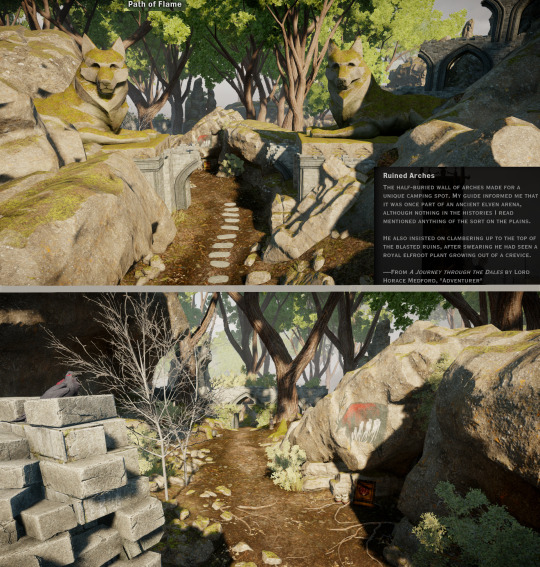
The Path of flame, a name designated by the Chantry to this part, looks like the entrance of a bigger elven ruin, which is protected by two big Fen’Harel statues. The landmark we trigger around this area, extremely unreliable, suggests that this place was an elven arena. I hardly believe it, but certainly there is something about gathering many elves and forcing them to walk certain paths [aka, a path to mark slaves? considering the paintings]. The truth is, that the game has showed us two elvhen arenas already: In Emprise du Lion, called currently by orlesians names since the original ones were lost to the ages: Etienne’s Ring and Leontine’s Ring, which are now used by dragons. So, I have to say that despite not trusting this source in the slightest, the Ruined Arches of Exalted Plains have a similar look to those we see in Emprise du Lion. So maybe elves had rings after all but the purpose of them is completely unknown.

In this zone, we find a solitary statue of Fen’Harel on the waterfall.
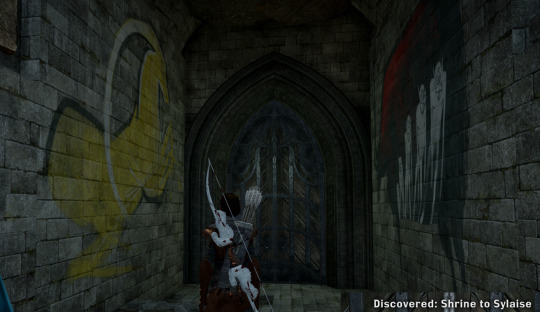

Some meters away from it, there is a Shrine to Sylaise, which entrance is decorated in the same fashion than the Ancient Baths: two archers indicating the entrance, and two paintings depicting a yellow halla and a black halla wtih elves wearing vallaslin.

When we enter the temple, we only find crypt-related elements: inuksuit and urns, and a codex of Sylaise is triggered: Sylaise: the Hearthkeeper, which is the usual one we find in DAO, and extremely unreliable.

Inside the temple there is a small corner covered with a barrier, where a body can be found. This body has a valuable historical talisman of the Dales elves, and an ancient elven robe. It's not clear to me how to understand the situation in which we find it.
This talisman belonged to an historical warrior of the Dales, and since we find a Robe that looks like the same one than the Keeper of the Clan we met, I assume this body was an ancient Keeper who wanted to protect that talisman from the shemlen, and made a barrier with themselves inside, or they activated some trap of the small shrine and got caught in it..
[Index page of Dragon Age Lore ]
#Exalted Plains#elven design#Andrastian design#guardian of the path#paintings#Strange Skull-Dragon totem#Sitting Fen'Harel statue#Razikale Ceremony#Horned warrior holding a sword#Tevinter objects#aravel#dalish design#elvhen design#Elven Owl statue#Elven hart statue#Elven Archers#playing DA like an archaeologist
37 notes
·
View notes
Photo
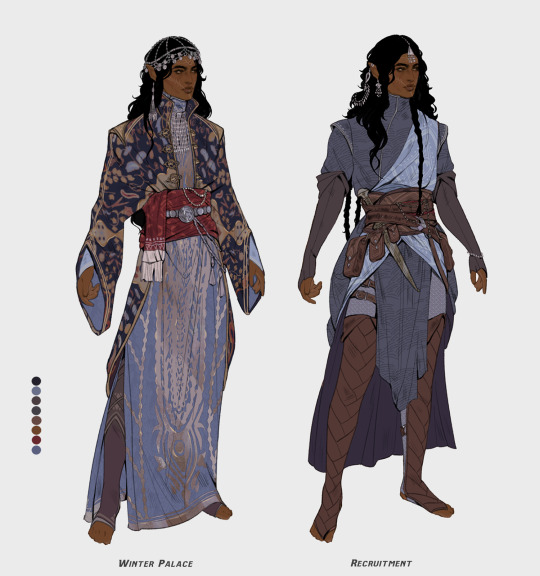
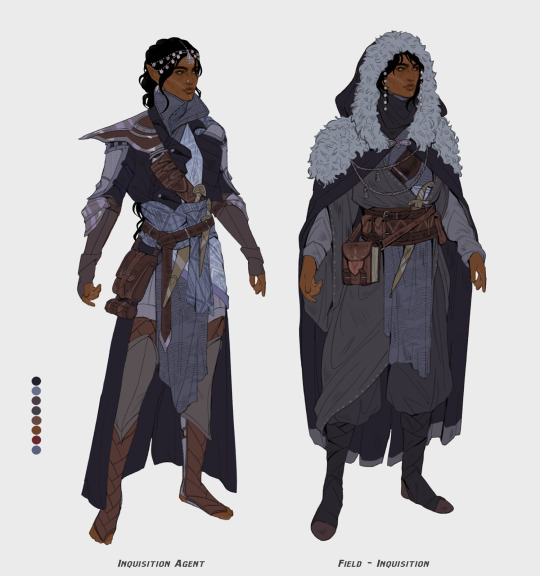
Some Ashura outfits bc dalish elf rights
#ashura lavellan#Dragon Age fanart#da fanart#he's not an inquisitor but he's the twin brother of my inquisitor asma#dragon age inquisition#dai#BioWare#my art#artists on tumblr#dnd#Dungeons and Dragons#lavellan#Outfit lineup#swana elf appreciation hours#dnd character#dalish elf#digital art#character design#elves of color
10K notes
·
View notes
Text
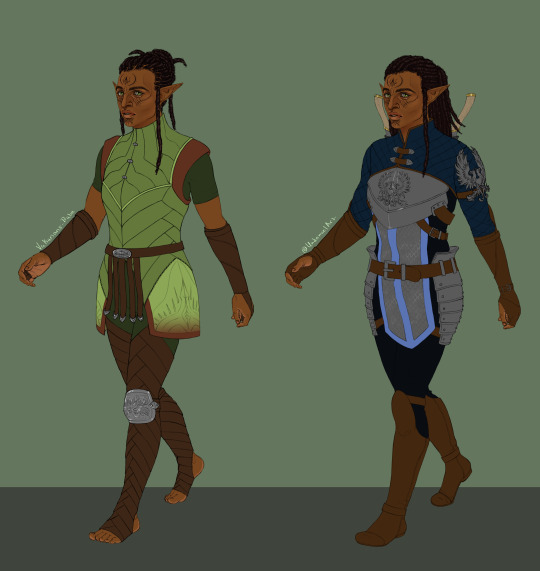

A wardrobe sheet commission I've been sitting on for a little while: the looks of Nesryn Mahariel, Hero of Ferelden and Commander of the Grey. Some details under the cut!
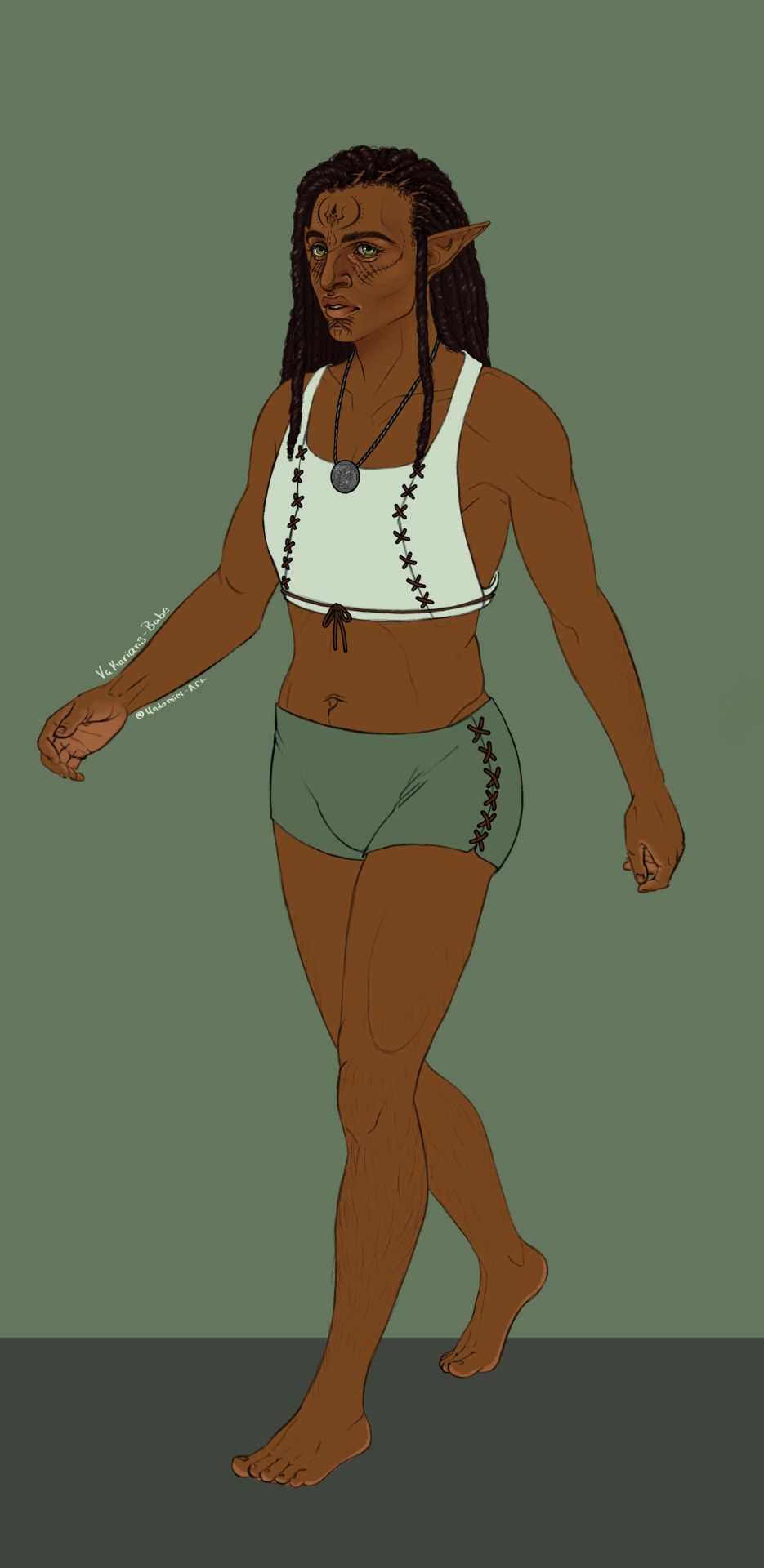


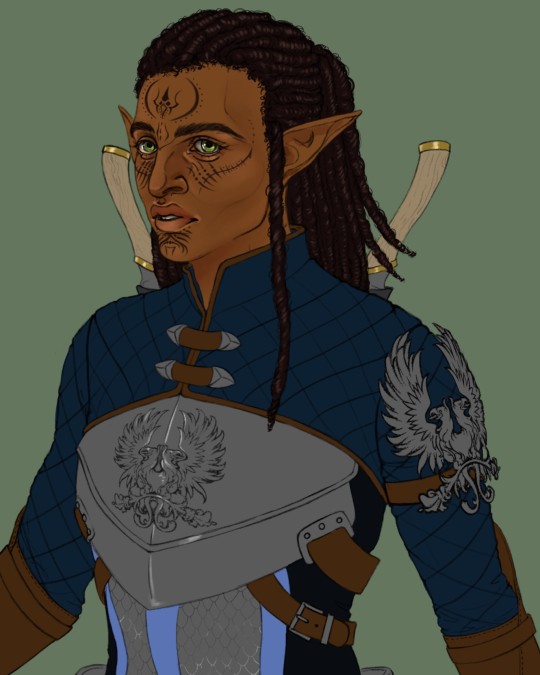
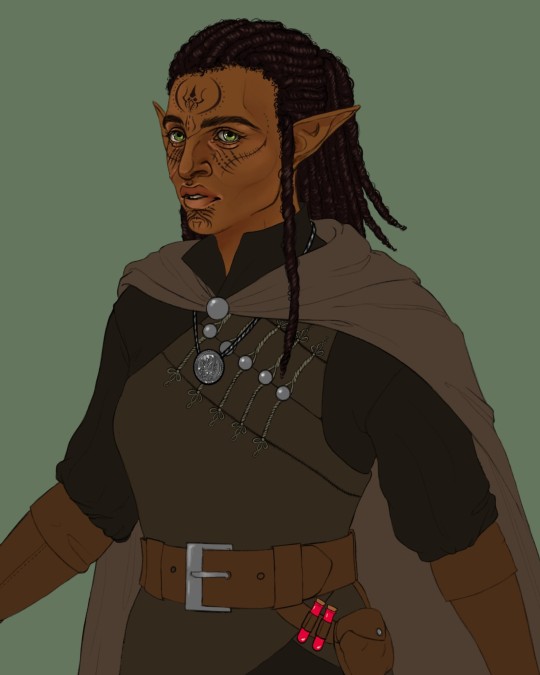


#laura arts#commission#dragon age#warden mahariel#dalish#grey warden#mahariel#dragon age origins#da origins#wardrobe design
68 notes
·
View notes
Text

I have been working on my character design portfolio, so here are some little designs for Ilonen, my Dalish elf Crafter OC :)
#art#dragon age#dalish#dalish elf#dragon age dalish#dragon age elf#DA#original character#character art#character design
129 notes
·
View notes
Photo
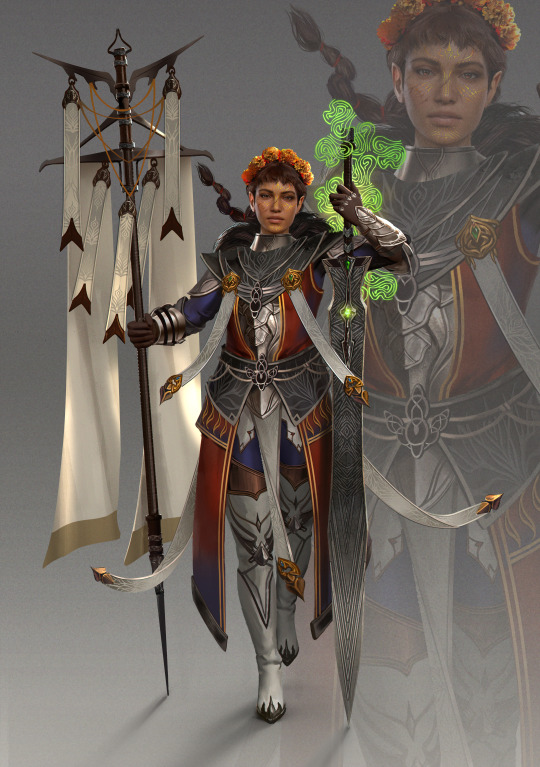
Inquisitor Ixchel Lavellan, the Brave Guide
GerryArt Links: Twitter, Instagram, DeviantArt, ArtStation, Ko-Fi
Give the artist some love! I can’t recommend Gerry enough.
I’m absolutely in love with this concept art of my Inquisitor. Gerry truly made her look like the Champion and leader she is!
Gerry’s an amazing artist to work with and incorporated so much imagery from the ideas I sent him and the blurb I said about her character, which is explored in my fic: Dead Pasts and Dread Futures.
Alternate version below the cut.

Gerry sent me three or four initial 3D mock ups of the poses and then kept me in the loop with his process, getting back to me super quickly with a very detailed initial piece and being super receptive to making changes or adaptations (not that I had a lot, Gerry did amazing!)
details i've noticed that are entirely from Gerry's fantastic brain:
- on the grey parts of her coat, is the Dalish crest (the mask with branches on it)
- her waist area has inquisition/chantry flame decals
- there are eyes all over her armor
- the banners have peacock feather elements in subtle satiny details
- ribbon in her braid!
- her BEAUTIFUL boots
#inquisitor lavellan#solavellan#gerryart#lavellan#concept art#dragon age character#oc art#commission#armor#illustration#dragon age fanart#dnd character#arms and armor#ixchel lavellan#my HEART#my SOUL#YOU CAN ZOOM IN SO FAR#MY BABY#i've been incorporating dalish banner crown details in her design from day one but NEVER has it been done SO BEAUTIFULLY#IT'S SO BEAUTIFULLLLL#art for blue
716 notes
·
View notes
Photo




The last one( for this week) pre-conclave outfit. And some detail`s
#lavellan#dalish elf#my art#concept#outfit#character design#costume design#dragon age#dragon age inquisition#dA fanart#inquisitor lavellan
94 notes
·
View notes
Text

I thought about how a rol reversal would look with my DA main characters, here's the concepts for Rune🖤
Champion!Rune never went to the Circle because she was better at hiding her magic (not like Canon!Rune who has lived all her life in the Circle and doesn't know anything else) I'm guessing her family moved to Kirkwall just because a lot of refugees seemed to, and stablished themselves at the Alianage, but Rune grew a reputation the same way, being extremely resourceful and very powerful. I have fun picturing her with a family since Canon!Rune doesn't know anything about her past. She would get along really well with Anders but they don't have the same close brother/sister relationship they have in my canon. And she would adore Merrill, she's fascinated by Dalish culture because Rune is and always will be a nerd. I think she would romance Fenris which is really funny cause he's the only character I haven't romanced in canon (besides Sebastian)
Inquisitor!Rune is the First of her Clan, just like Lavellan, she mantains her serious and cold personality, with a goofy side nobody sees coming. And extremely against everything about the Inquisition especially them trying to deny her heritage so she'd be really agressive about that. Like the Champion version I had fun envisioning a universe where she knows her biological family and her Clan. She gets along mostly with other mages because like I said she's a nerd and she loves studying, especially Solas. But she would be fascinated by Sera and Cole. In this case I don't know who she would romance, I don't think any of them are her type.
#mine doodles#dragon age#dragon age origins#dragon age 2#dragon age inquisition#rune surana#rol reversal au#champion!rune#inquisitor!rune#city elves#dalish#city elf#surana#warden surana#the warden#my art#digital art#character design
56 notes
·
View notes
Text
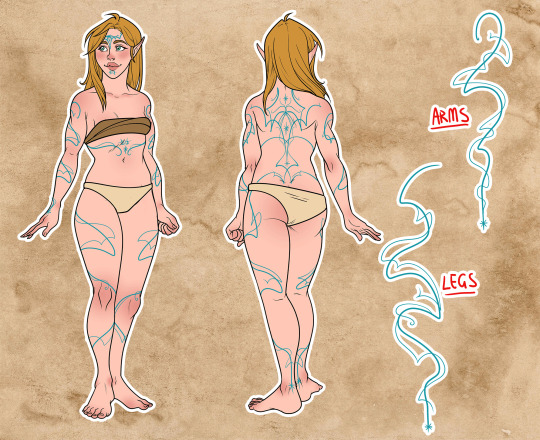
"Yeah the one on my belly hurt… THAT woke me up, I was having such a good nap… :/"
I'm posting so it gives me the impression that it's done.
So yeah, working to some better concept for Aisling, starting with the Vallaslin. It's in teal, it's for Ghilan'nain, I picture she fell asleep at some point and the Keeper just... Went on until she woke up.
Also if you'd like I'm open for prompts!
#dragon age#dragon age inquisition#dalish inquisitor#concept art#da fanart#da art#dai#aisling lavellan#tattoo design#vallaslin#character concept#greypetrel
91 notes
·
View notes
Photo

Ariane
Her clan’s best hunter.
I had the urge to draw my favorite Dragon Age warrior in her fully tricked-out Dalish armor as seen in Heroes of Dragon Age. <3
#dragon age#ariane#my art#dragon age witch hunt#witch hunt squad tag#hide helmet option is turned on because i did not like the helmet they designed for her#and it covers up too much of her vallaslin#also feel like this piece should exempt me from ever having to draw her armor again x.x#dragon age origins#dalish elf#dalish
339 notes
·
View notes
Text
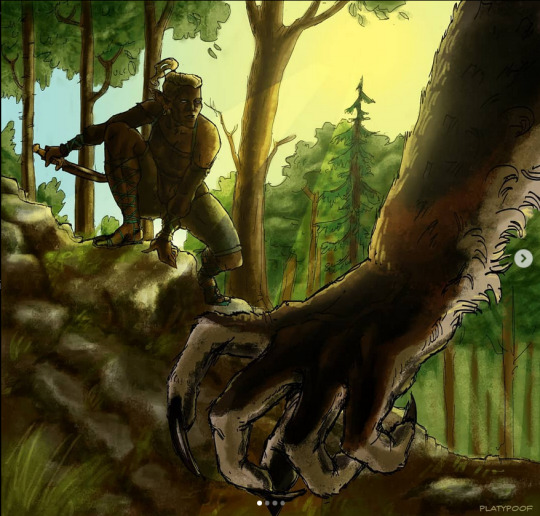

''Thought y'all came out durin' the full moon, not high noon''
I'm so mad i can't find the original file of this drawing. Anyway, it's an older piece so excuse the insta crop. I normally keep all my art on my drive but i remember being busy with school i just forgot. ugh
will be postin older stuff here
#digital art#art#illustration#character design#digital illustration#fantasy art#digital artist#mythical creatures#digital painting#character art#werewolf#elf#dalish#dragon age
9 notes
·
View notes
Text
The Crossroads [DLC Trespasser]: Elven Mountain Ruins , Forgotten Sanctuary; Vallaslin Removal Chamber and Hidden Armoury
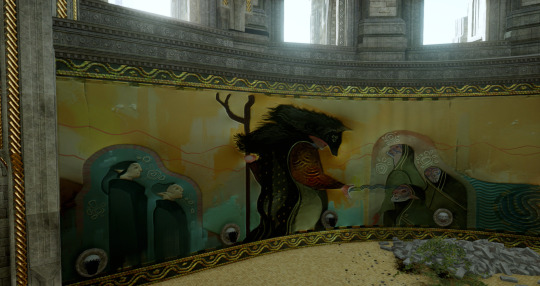
In the time of Elvhenan, this valley was a sanctuary created by Fen'Harel to give shelter to elven slaves. He rejected the divine mantle himself and taught the refugees the truth about the Evanuris in the surrounding towers. In the Forgotten Sanctuary, Fen'Harel removed the vallaslin, giving the now free slaves the chance to join his army in order to fight back against the pretender gods.
[This is part of the series “Playing DA like an archaeologist”]
[Index page of Dragon Age Lore]
The Vallaslin Removal Chamber

Here, we find one of the murals of DAI [I make a deep analysis of all the murals in “Murals in DAI”]. For now I can say, briefly, that I’m not so sure if this one was made by Solas.
We know his technique is not unique, it belongs to the ancient elves [proof of this is given by the archivist Banon of Skyhold in The Rotunda and the Fresco]. Technically, any educated elf of the past could have done it.
We already saw how much of a romantisation of Fen’Harel was done in the mosaics of Fen’Harel’s mountain ruins, so this mural may perfectly be part of them as well. My main argument to put in question this is that we never saw Solas draw himself in the way he is presented here, so I’m a bit sceptical about his authorship.
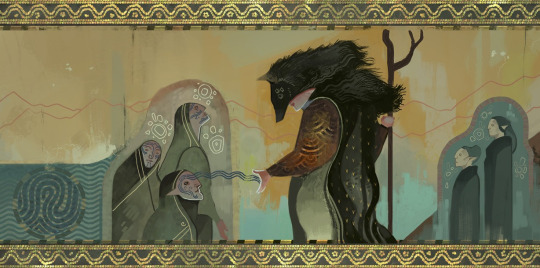
This mural pictures Fen’Harel as a person wearing a wolf cape and a fine robe. The intricate patterns of the fabric makes him look more important, more “Evanuris”, when he usually draws himself with the same kind of robes than the slaves are wearing: a black and green simple robe. I think there is an intent of idealisation of Fen’Harel by making his outfit fancy and more elaborated.
The figure is covering his face with a wolf mask [so, technically, anyone can take this role] and removes the vallaslin of the slaves. To me, this figure represents, ironically, a “priest” of Fen’Harel, a representative that embodies Fen’Harel’s (romanticised) ideas and shares and applies the power that Fen’Harel himself gave them [aka, the spell to remove the Vallaslin]. This figure could be a mage that knows the spell and removes the Vallaslin in groups of recently arrived slaves.
We saw the removal of the Vallaslin in the romance scene of Solas: it’s a mere spell that doesn’t need any great material or fashion to perform, it’s easy and doable if you know the spell. Another extra detail to support this suspicion is the figure’s staff. That’s not Solas’ staff.

We know his staff from his tarot card (number 1), it is a kind of a “halla profile” with a very messy set of horns. In the mural of the red lyrium idol, he painted his staff (number 3) closer to the design of 1 than 2. Staff 2 seems to be a generic branch made into a staff.

Continuing with the mural, the elves come from a blue water pool which contains inside the shape of an elven orb.The water is drawn with undulating blue lines that can represent mere water, or lyrium pools [if we want to link this to The Horror of Hormak]. These waters are a product of the Evanuri’s power: from these waters, the elves come out, slaved and branded. Similar undulation can be seen in the vallaslins coming out of their faces, and in the borders of the aravels, giving us some hints to point out to The Horror of Hormak. These undulating lines appear too in the spheres of the Mural of “The Creation of the Veil” that we find in the Shattered Library. The relationship between undulating lines, orbs, and vallaslin seem to be rather consistent, and I trust this interpretation more than others.
Now, something that I will owe, because I have no idea about yet, are those white drawings over the heads of the elves. No clue what those could be.
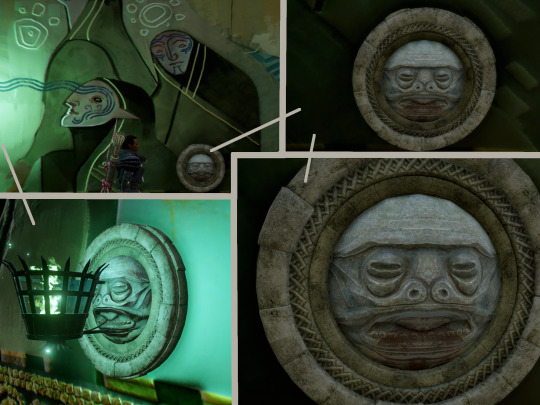
For some unknown and unsettling reason, this mural has the face of the The Strange Idol repeated four times, with its mouth stained in (dry, I assume) blood. We have seen this exact circle with his face in Emerald Graves: Din'an Hanin and in Emerald Graves: Din'an Hanin, Elandrin’s Tomb. One of these heads holds the brazier from where you can cast Veilfire.
Does this have any meaning? I’m not sure. We are not sure who this figure represents yet. The furthest we reached was Elgar’nan, thanks to the description in Signs of Victory as I commented in Ancient Elven codices; Vir Dirthara and thanks to the name of the zone [Elgar’nan’s bastion] where we find his statue in the middle of Elandrin’s Tomb. But we don’t know who named this place like that, so we don’t have anything truly reliable to identify this statue. So far, we can only suspect it to represent Elgar’nan, while some Tevinters considered it Dumat. More details about this unsettling figure can be read in The Strange Idol.
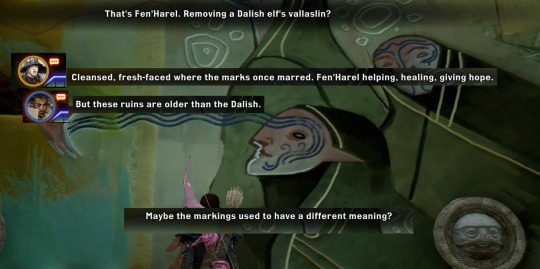
The Inquisitor and their companions make remarks about this mural: we are introduced here to the concept that the Vallaslin was a different kind of mark [this knowledge is only truly known by female inquisitors who romanced Solas]. For more details, check the post about “Murals in DAI”.

To activate the statue of Fen'Harel, we have to solve a small simple puzzle. Curious detail, in front of the Sitting Fen'Harel statue we find a Stone in Razikale-Ceremony-style. This combination of elements will be repeated along the Crossroads and the small pocket worlds we visit: The stone that gives us a clue to solve the puzzle of the Sitting Fen'Harel statue is a Stone in Razikale-Ceremony-style. Mere reuse? I'm a bit lost with this stone since it appeared in the Fairel's burials. More about this stone was discussed in Razikale Ceremony and Dumat’s Warrior tablets.

Once we solve the puzzle, Fen’Harel statue moves, opening the entrance to the basement. We have access to the last mosaic:

It narrates what we saw in the previous mural: the removal of the vallaslin. For more details, read Ancient Elven codices; Fen’Harel’s mountain ruins.
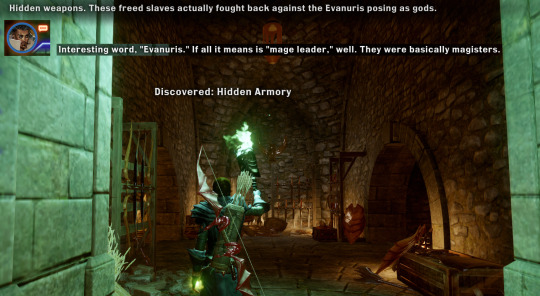
As the mosaic disappears, it gives us access to the Hidden Armoury, where we see the arsenal of weapons that the rebels had to fight against the Evanuris.

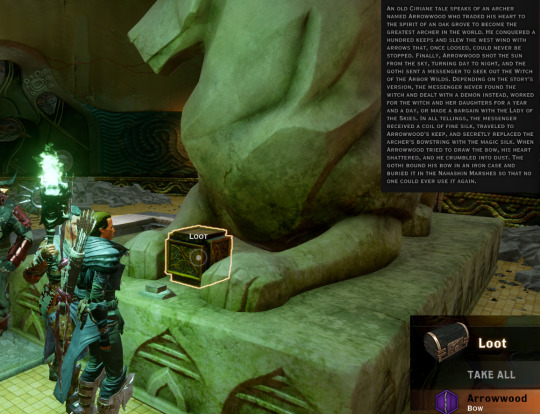
In the Armoury, we read a report left by a qunari agent about an elven artefact in the box laying between Fen'Harel's paws. However, if we return to it and inspect it, we realise it is not elven [this shows how little Qunari know about elves and elvhenan craftsmanship]. Here we find Arrowwood which is associated with ... well, many things.
It speaks of a Ciriane tale, an alamarri tribe from which Andraste comes from.
We don't know the race of the main char of the story, we assume is human [but we know that the Alamarri have been mixing with other races without much problem, so they could be a half-dwarf].
He removed his heart to have mastery in the bow. There are two stories related to a creature that removes their heart: Korth, and the story that the elves narrate with the mural of the Titan: “The Death of a Titan”
This char shot the Sun, causing eternal night. This concept links him with Elgar'nan who fought the Sun or pushed it down into the earth depending on which unreliable story you based this on.
The queen of the Ciriane [called gothi] sent a messenger to the Witch of the Wild to stop him.
Depending on the story, the messenger never found the Witch and made a deal with a demon. Or worked for the witch and her daughters for a year. Or found the Lady of the Skies. In all three versions, we can interpret the same: the messenger found Flemeth [since she is an abomination with certain anomalies she qualifies as a demon for many tales. She is a also a witch of the wild, and she has a big potential to be the Lady of The Skies in some shape or form]
In all cases, the messenger received a coil of silk that he used to replace the string of the bow of the Arrowwood.
When Arrowwood tried to use the bow, his heart shattered and he became dust.
The queen took the weapon, encased it in an iron chest, and dropped it in the Nahashin Marshes.
Now, how and why a weapon of Ciriane nature, that has some resemblances with titans, Korth, and Elgar’nan, ended up in an ancient elvhen chest, from a time before the arrival of humans to the world? If it's not an elven weapon, it makes no sense for it to be here. And one can argue that this could be similar to the case of finding the Chapter ??? of Hard in Hightown in the Lower Archives, but I feel that such chapter makes more sense as a way for the devs to tell the players that whoever was left in the Fade, died in peace. It’s closure to a narrative. Now, this doesn’t make sense in that way either. One could assume this is just pure game mechanics and thinking too much about it is wasteful. It’s a good weapon after all.
Hidden Armoury
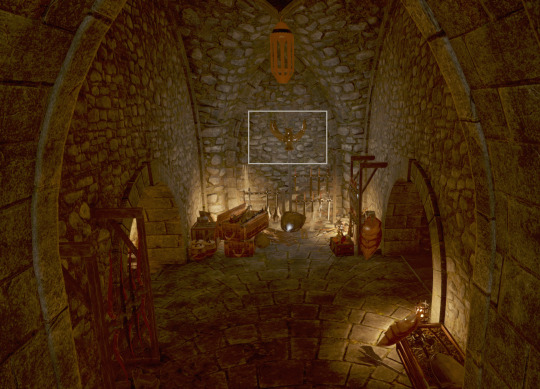
The first thing we see when walking downstairs is, besides all the weapons, a curious statue of two birds in a strange amalgamation. So far I'm aware, we never saw similar statue anywhere in the game [I tend to overlook Orlesian stuff, but I feel this statue would have got my attention anyway] .

It's two birds [maybe ravens due to their beak?] joined by their backs, and struggling to fly. The first idea that came to me when i saw it for the first time was the two ravens of Dirthamen: Deceit and Fear [if we indulge in the unreliable Dalish tales]. But it makes little sense. It's true that Dirthamen is present in this sanctuary more than we have expected, and he is also present in the first tower where we enter [ the Vine-covered Tower]. But what would be the meaning of placing his ravens, fused, in the armoury? This symbol here escapes me.
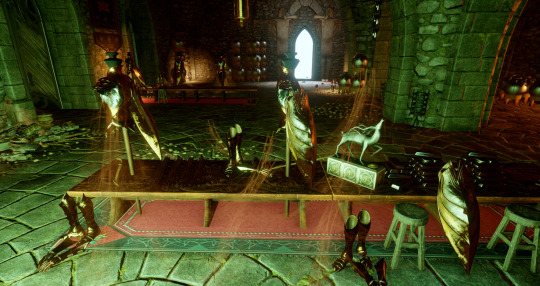

This place is filled with elvhenan weapons and armours [similar to the ones we saw Abelas and his elves wear in the Temple of Mythal].
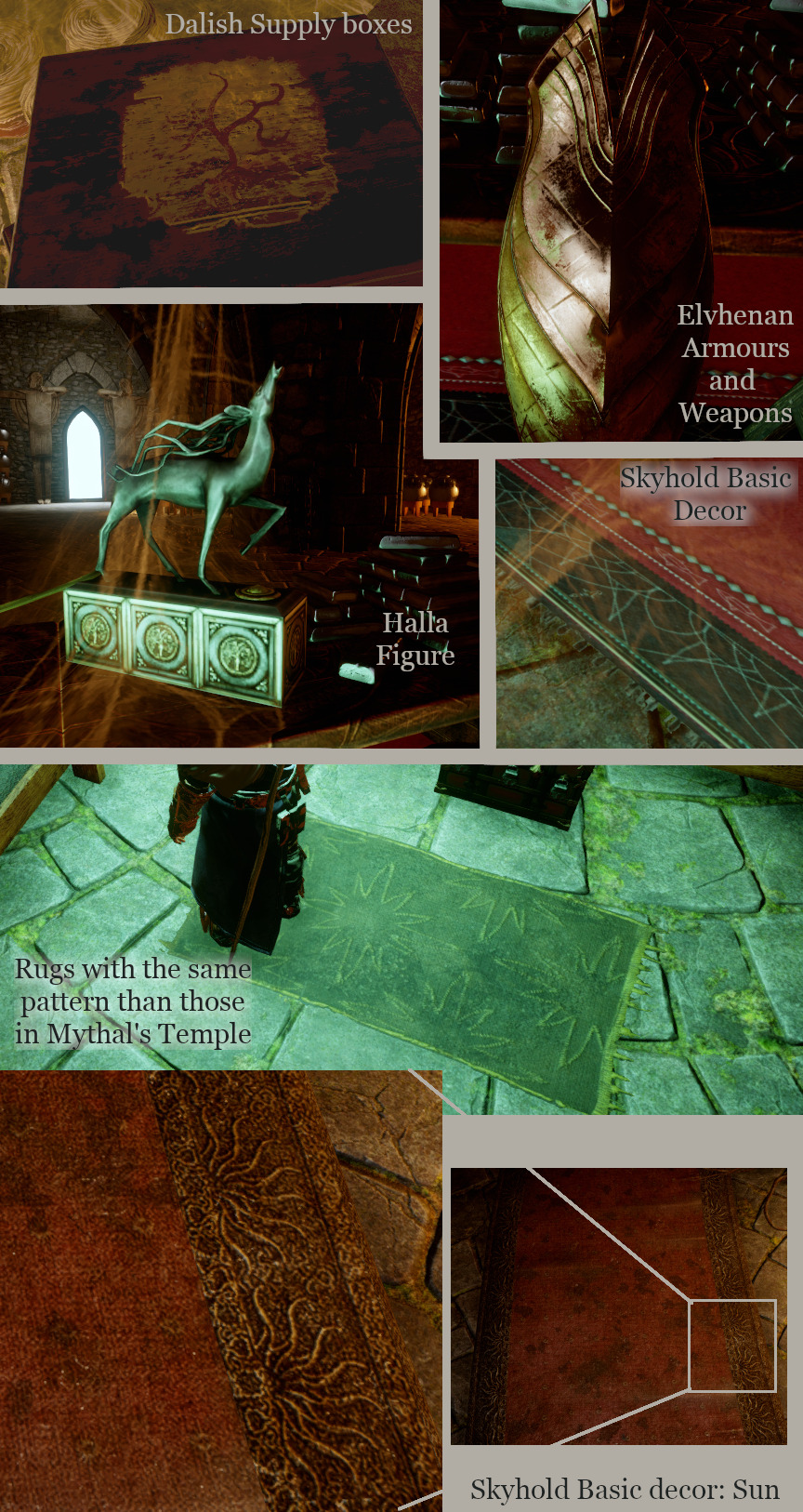
We find in addition to more Dalish supply boxes, Hallas statues that we know in game have been used by the Valmont family to create a system of locking doors in the Winter Palace, and three different kinds of rugs:

One red and black, with geometrical patterns and small "fishes" in it. It's a rug we can find in Skyhold under the basic option [meaning, Skyhold may have had a link to the activities done in here]. On its corners we see two small dogs [?] attacking a simple-horned halla/deer.
There are smaller rugs in the rooms, featuring stars of 12 points. These rugs are the same ones we saw in the Temple of Mythal, placed in front of the Mosaics, giving the idea of being used to kneel and pray. And a last carpet that, in a first impression, seemed to be Chasind, but it is not. It is an old red carpet which has a border pattern that looks like a half-sunburst [similar to the Chantry symbol indeed].
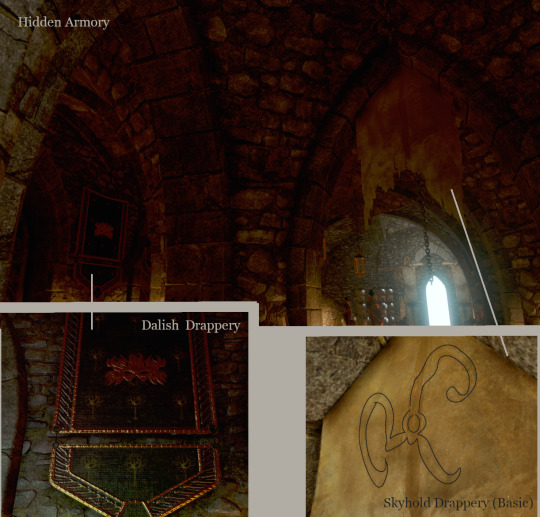
In terms of drapery, we find two main options: the typical Dalish drapery, with the "mask" that in DAO represented Mythal, with a pattern of spherical trees on the background. And the second drapery that caught my attention was a series of ragged, discoloured flags hanging along the entrances of the armoury. It had a very curious symbol on it that I retraced. I've never seen this design. It looks a bit [with a lot of will] like "tentacles", which is not a big thing in DA series anymore, since in DAO the option of making the Old Gods as strange Eldritch creatures was removed due to the limitations of the engine or to add dragons instead.
This symbol, however, appears in another place: in Skyhold, when you pick the basic decoration. Once more, it seems that Skyhold and this hidden armoury may have had some link in the past. Who knows if some of the broken eluvians in this place may have been related to Skyhold long ago. We also know that Skyhold was used by elves long time ago, and suffered strange damage, specially in the section of the jail, that the game leaves it free of any explanation [Prison Structural Evaluation]. At the end of Trespasser we know that Skyhold was Solas’ fortress at some point, so the link with this armoury is not that strange anymore.

The eluvian to gets us out from this Armoury is flanked by two archer.
Extra Details
Along the exploration of these ruins, we find details worth mentioning.
The purple fire

In some parts there is a purple fire that, no matter what you do, it kills you. The only way to cross it is through powers that provide you invulnerability for a while, one of them is the use of discharge of the Anchor. What this means lore-wise?
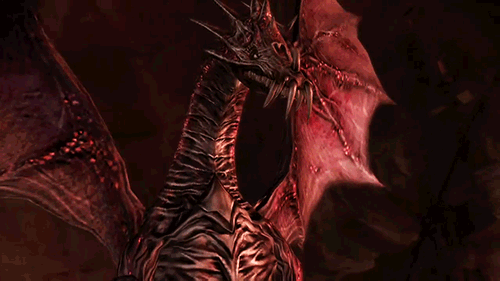
This fire is visually the same kind of fire that the Archdemon from DAO breathed and it’s now Solas’ current power. I fear so much to connect excessively things that are unrelated, but on the other side, DAI in particular has proven to be such a detailed game, that something of the like, so visual, has a good chance to be intentional. I’m not going to say that Solas is an archdemon, because we still don’t know what truly is an Old God [the non-corrupted version of an archdemon]. We only know that Urthemiel was worthy to be protected according to Mythal’s actions, so the relationship of these powerful elvhen mages with these old dragons is not clear yet but the relationship seems to exist.
The design in general


I like the design of the Elvhen banner and how it relates to Dalish and Tevinter design. That the Dalish banner is a more elaborated version of the Elvhen banner is not a surprise to anyone. It’s the same object with some extra “orlesian-like” ornamentation that can be justified for the years of coexistence between the Ancient Dalish and the Orlesians in the Dales, before the Exalted March.
However, I think it’s worth noting how Tevinter design is, yet again, based on Elvhen design, specially the one related to arcane. Tevinter banner has a shape on its top that resembles an oversimplified raising dragon [like the symbol of Emerius, ancient Kirkwall] but it also can be seen as a thicker and compressed version of the top of the Elvhen banner. Both of them inspired, at the same time, by the shape of a dragon or an owl extending its wings.
This comment is not meant to relate crazy lore stuff, but it is basically to highlight how the design of these objects is also related to the History they represents, and who co-opted what. Dragon Age Inquisition is such a detailed game in terms of design that, for that reason, I’m doing this extensive comparison and studies of the statues and art we see in it. It’s not mere whim, they truly worked a lot on this stuff. The director art and the artists who worked on this game, REALLY thought a lot how real life civilisations base their design, culture, and religion on previous ones, modifying them or mixing them with others, to the point that it’s hard to identify the original inspiration. And I’m truly convinced that DA series is a lot about the exploration of this concept in many levels and cultures.
#Playing DA like an archaeologist#dai trespasser#dlc#tevinter design#dalish design#skyhold drapery#rug#two ravens#Sitting Fen'Harel statue#strange idol#The Strange Idol#Evanuris Mosaics#fen'harel#murals#vallaslin#purple fire#elvhen design#undulating#DAI murals
17 notes
·
View notes
Text
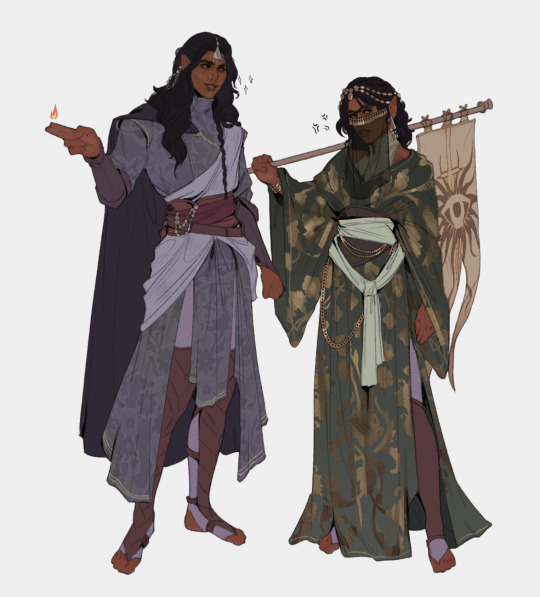
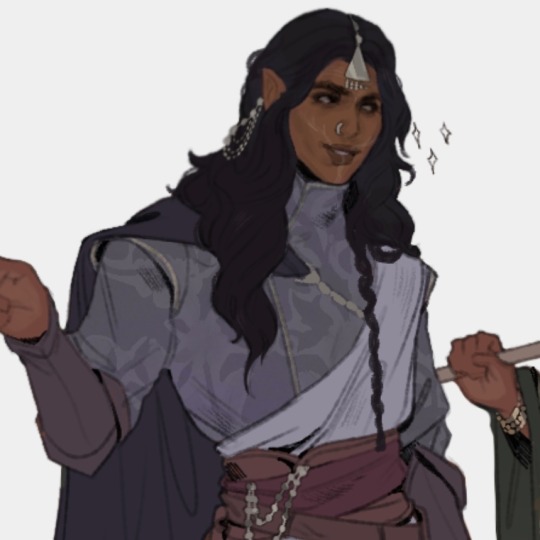
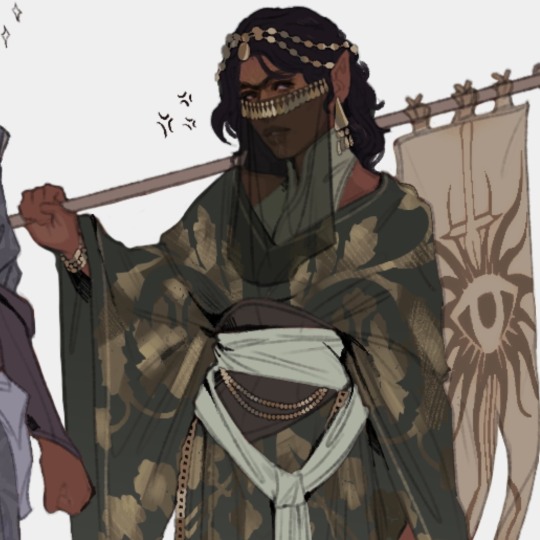
Fave lavellan sibling duo
#dragon age#my art#asma lavellan#ashura lavellan#dragon age fanart#digital art#artists on tumblr#BioWare#da fanart#elves of color#lavellan#inquisitor lavellan#dalish#character design#original character#oc#Asma is just in a constant state of wanting to punch him#dragon age inquisition#dai
4K notes
·
View notes
Photo

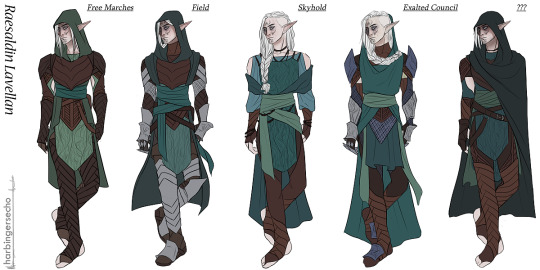
some possible outfits i drew for one of my inquisitors, raesaldin + a headshot
#dragon age#inquisitor#dragon age inquisition#clan lavellan#concept art#character design#dalish#dai#da#art#mine#*22#raesaldin
28 notes
·
View notes
Text
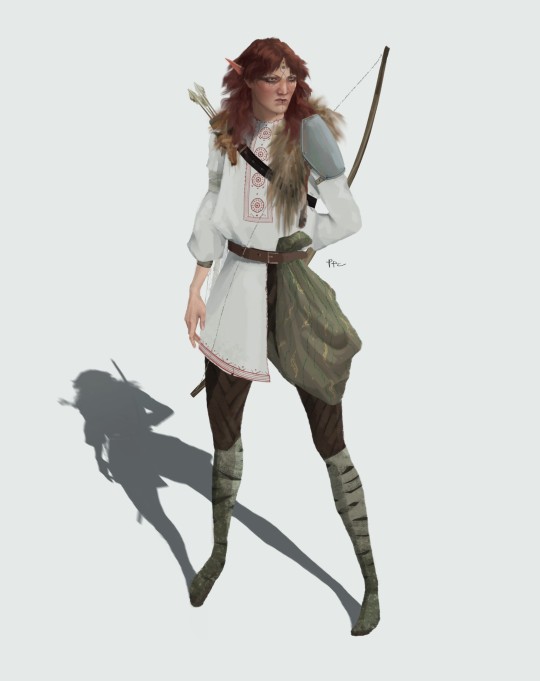

original and DA AU version
can't believe I finally finished it
#dragon age fanart#elf#dalish elf#character design#artists on tumblr#art tag#oc:lenka#not pictured: aedan cheering in the background screaming THAT'S MY GIRL.#he's very proud lenka let him be her partner yk
130 notes
·
View notes
Text
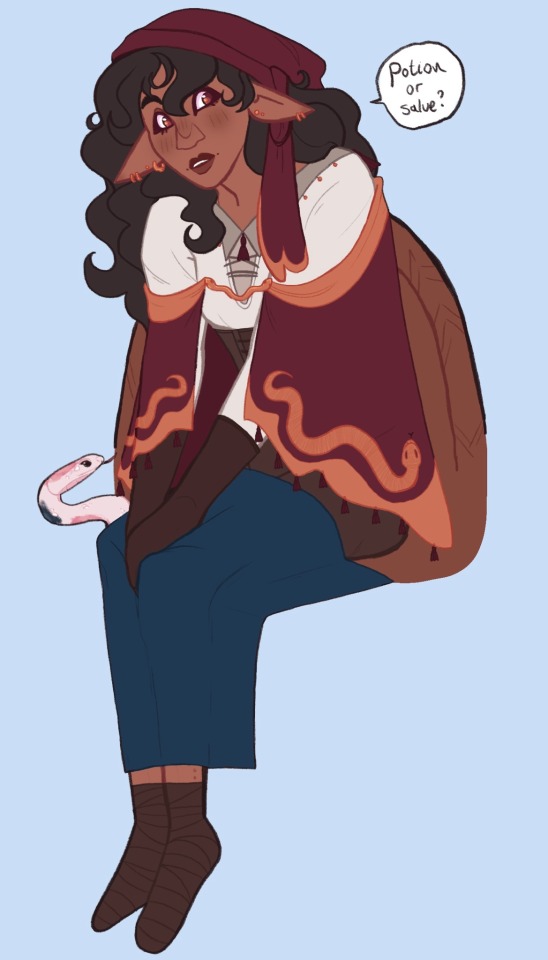
Not sure yet which clan she belongs to but Vesa and her little companion Andi
(She’s missing her Vallaslin in this)
But if you want potions, salves, toxins, poisons or antidotes. Then you came to the right place, there’s no one more skilled in her craft and if given the proper time there’s next to nothing she can’t find a solution to with her alchemical skills. Some even seem to have magical properties, despite her being a non-mage
#dragon age#art#oc#original character#design#character#dragon age oc#Dalish#elf#Dalish elf#pretty women#omg I am in love with her#lesbian oc#sapphic oc
6 notes
·
View notes
Note
i think part of the reason why lavellans are so popular is bc the game kinda. centers itself on a bunch of old dalish stuff (but then says "hey they sucked actually, & we're rewriting a bunch of lore to make them this way"). you get more out of the game playing an elf imo, as sad at that seems from a gameplay/writing standpoint :/
oh yeah that’s true ig
#especially w a romance available that like. is only designed for one origin so is very tailored to that origin if that makes sense#idk i havent gotten super into all the dalish and ancient elves lore yet i havent done a full dai run or a full dalish playthrough#of any of the games#i’ll probably be more invested in lavellan once i’ve done dai and mahariel
20 notes
·
View notes